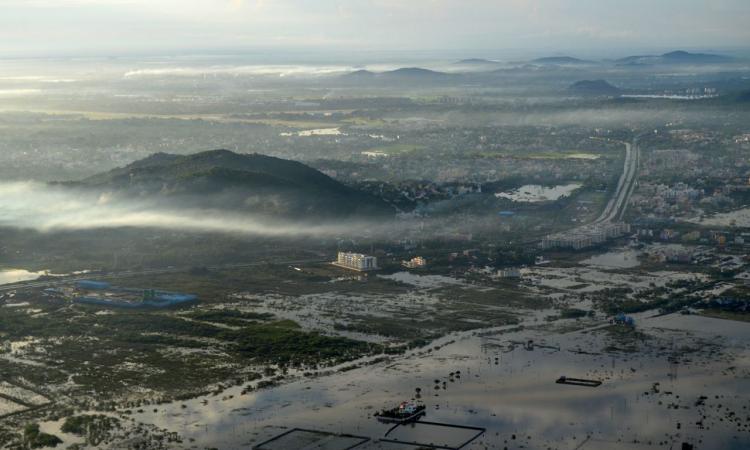
A new research study by Climate Central, a US-based non-profit research group has projected that 300 million people could face annual coastal flooding triggered by climate change by 2050. Scott A Kulp and Benjamin H Strauss, the authors of the study suggest that the choices made today will likely determine whether our planet’s coastlines will even be recognizable, by the middle of the twenty first century. The findings reported in the journal Nature Communications are based on CoastalDEM, a new digital elevation model developed by Climate Central.
By 2050, coastal areas - currently home to 300 million people – will be extremely vulnerable to flooding, irrespective of how seriously humanity controls carbon emissions. Destructive storm surges fueled by increasingly powerful cyclones and rising seas will hit Asia hardest. More than two-thirds of the populations at risk are in China, Bangladesh, India, Vietnam, Indonesia and Thailand.
Previous studies underestimated risks to coastal zones during high tide or major storms
As per Climate Central, coastal flood risks assessments so far based on NASA’s Shuttle Radar Topography Mission (SRTM) had vastly underestimated the elevation risks. SRTM measured elevation of surfaces closest to the sky such as tree tops and rooftops wherever they blocked the ground. Researchers studying the impact of rising seas on human settlements have long known that the SRTM has a fairly large margin of error. CoastalDEM used by Climate Central has reduced these errors by using a form of artificial intelligence known as neural networks, thanks to which the new research has corrected ground elevation data. CoastalDEM’s sophisticated modeling techniques are more accurate and “reduces linear vertical bias from 4.71 m to less than 0.06 m”.
According to SRTM data, only 5 million people in India were expected to face coastal flooding by 2050. But, as per CoastalDEM used by Climate Central, it is actually 36 million by 2050 and 44 million by 2100 if emissions continue to rise unabated. Nearly 21 million — and not 2.8 million — are expected to be living below the high tide line, the boundary that marks the farthest to which the sea reaches into the land at high tide.
The study further indicates that by 2050 high tide lines could permanently rise above land occupied by some 150 million people, mostly in Asia. The worst impacts would be faced by Bangladesh and China where about 93 and 42 million people respectively are likely to be affected by severe coastal flooding by 2050.
“Bangladesh, India, Indonesia, and the Philippines see a 5-fold to 10-fold change in estimated current populations below the projected high tide line after applying CoastalDEM,” the study says.
In the 20th century, the global mean sea level rise was of the order of 11-16 cm. Even with sharp cuts to carbon emissions, it could rise another 0.5 metres this century. Under higher emissions scenarios, the rise may exceed 2 metres by 2100. Rise in sea levels in the 21st century may exceed 2 metre due to early-onset Antarctic ice sheet instability.
Based on unchecked emissions (not meeting the 2015 Paris Agreement) Climate Central also estimates that this could lead to sea level rise that could threaten areas where about 640 million people now live. 340 million of these people could fall below the high tide line by 2100. In eight Asian countries, regular high tides would be higher than land which is currently home to at least 10 million people.
Rising seas, sinking cities
Climate change has the potential to reshape cities, economies, coastlines and entire global regions within our lifetime. Coastal megacities will be forced to adapt or move out of harm’s way. Even now, over 100 million people are living below high tide levels, some protected by dikes and levees, while most are not, the study found.
The expansion of water as it warms, and the melting of ice sheets atop Greenland and Antarctica will lead to catastrophic problems. Around 430 billion tons of ice per year has been shed by these glacial sheets over the last decade. A warming atmosphere will also amplify tropical storms - like typhoons, cyclones and hurricanes, leading to a crisis of extreme weather events.
An IPCC report had found that major storms that until recently occurred once a century will, by 2050, happen on average once a year in many places, especially in the tropics. Annual coastal flood damages are projected to increase 100 to 1,000-fold by 2100 and many coastal urban areas will literally sink under their own weight.
"As the tideline rises higher than the ground people call home, nations will increasingly confront questions about whether, how much and how long coastal defences can protect them. The levees, seawalls and other defenses and accommodations currently protecting tens or hundreds of millions of coastal-area residents globally point to the potential for protecting ever-larger areas as seas rise. At the same time, current coastal defenses should not be assumed adequate to protect against future sea levels and storms without continued maintenance and, likely, enhancement," the study says.
The study findings indicate that coastal communities worldwide must prepare themselves for much more difficult futures than may be currently anticipated. Further research on global-scale modeling of the timing, locations, and intensity of migratory responses to increased coastal flooding is urgently needed to minimize the potential human harm caused by such threats.
The full paper can be accessed here